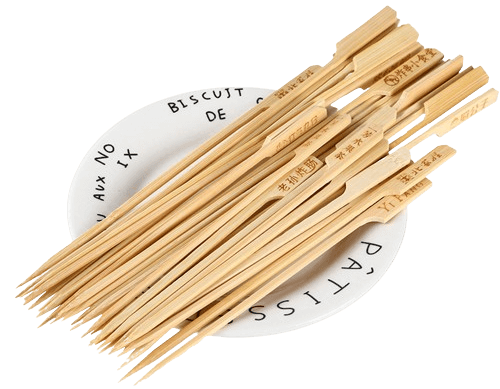Key Takeaways
| Question | Answer |
|---|---|
| What are chopsticks? | Chopsticks are pairs of equal-length sticks used as eating utensils, originating from China. |
| How did chopsticks evolve? | They evolved from cooking utensils in ancient China to eating utensils around 400 A.D. |
| What materials are chopsticks made from? | Common materials include wood, bamboo, metal, plastic, ivory, and ceramics. |
| What are the cultural significances of chopsticks? | They hold deep cultural significance in East Asian societies, influenced by Confucian ideals. |
| How are chopsticks used? | Proper technique involves holding one stick stationary and moving the other to grasp food. |
| Are there different types of chopsticks? | Yes, designs vary by region, including differences in length, shape, and material. |
At Ecostix Global, our mission is to revolutionize the way the world sees bamboo products. We strive to create high-quality, sustainable bamboo chopsticks and sticks that are not just utensils but symbols of a more eco-conscious lifestyle. Our focus is on blending traditional craftsmanship with modern innovation to produce items that are both environmentally friendly and aesthetically pleasing. We aim to inspire a shift towards sustainable practices in everyday life, making a positive impact on the environment while serving the practical needs of our customers.
Introduction
Chopsticks, used by billions of people worldwide, are more than just a tool for eating; they are a window into the rich tapestry of East Asian culture. From their humble beginnings as cooking implements in ancient China, chopsticks have evolved into an essential part of dining etiquette and cultural identity. This article explores the fascinating history, cultural significance, and practical use of chopsticks, highlighting their journey from ancient times to modern tables.
Historical Background
Origins and Early Use
Chopsticks originated in China, with the earliest archaeological evidence dating back to around 1200 B.C. These ancient utensils were initially used for cooking, helping to reach into boiling pots without the risk of burns. Over time, their use evolved, and by 400 A.D., chopsticks had become common eating utensils. This shift was partly driven by population growth and resource scarcity, which necessitated more efficient cooking and eating methods.
Evolution Over Time
As China grew and its cultural influence spread, so did the use of chopsticks. By 500 A.D., these utensils had become widespread across Asia, from Vietnam to Japan. Confucian philosophy played a significant role in their adoption; Confucius himself preferred chopsticks over knives at the table, believing that knives evoked violence and disrupted the harmony of a meal.
Cultural Significance
Chopsticks in Different Asian Cultures
Chopsticks are not uniform across Asia; their design and use vary significantly by region:
- China: Chinese chopsticks are typically longer and thicker, designed for communal dining around large tables.
- Japan: Japanese chopsticks are generally shorter and tapered to a point, which aids in eating fish and other delicate foods.
- Korea: Korean chopsticks are often made of metal and are flatter, used alongside a spoon during meals.
Chopsticks in Western Context
The adoption of chopsticks in Western countries has been driven by the growing popularity of Asian cuisine and the influence of Asian diaspora communities. Today, chopsticks are commonly found in restaurants and homes across the globe, symbolizing cultural exchange and appreciation.
Practical Guide to Using Chopsticks
Choosing the Right Chopsticks
When selecting chopsticks, consider the material and design that best suits your needs:
- Materials: Common materials include wood, bamboo, metal, and plastic. Bamboo and wood are preferred for their natural feel and ease of use.
- Designs: Chopsticks for eating are typically 9-10.5 inches long, while those for cooking are longer to keep hands safe from heat.
Basic Technique
Using chopsticks effectively requires practice and proper technique:
- Hold One Chopstick Steady: Place it between your thumb and the base of your index finger, resting it on your ring finger.
- Move the Other Chopstick: Hold the second chopstick like a pencil, using your thumb, index, and middle fingers. Move this chopstick to grip food.
Etiquette and Manners
Proper etiquette varies by culture but generally includes:
- Do’s: Place chopsticks parallel on your plate when not in use, and use the blunt end to take food from shared dishes.
- Don’ts: Avoid sticking chopsticks upright in a bowl of rice, as this resembles a funeral rite in some cultures.
For more detailed guidance, explore our articles on mastering chopstick techniques and etiquette: Mastering Chopsticks: A Cultural and Practical Guide.
Advanced Techniques
Once you’ve mastered the basic technique, you can explore more advanced uses of chopsticks. For instance, chopsticks can be used for:
- Cooking: Long chopsticks are ideal for stirring, flipping, and serving food without getting too close to the heat. They are particularly useful in deep frying and stir-frying.
- Serving: When dining with others, it is polite to use the blunt end of your chopsticks to serve food from shared dishes.
For an in-depth look at how to use chopsticks for cooking, check out our article on Mastering the Art of Precision Cooking with Bamboo Cooking Chopsticks.
Chopsticks in Modern Times
The global appreciation of chopsticks extends beyond their practical use. They have become a symbol of cultural heritage and sustainable living. At Ecostix Global, we are committed to producing chopsticks that honor traditional craftsmanship while embracing modern sustainability practices.
Cultural Appreciation
Using chopsticks correctly and understanding their cultural significance can enhance your dining experience and show respect for the traditions they represent. Whether you’re enjoying sushi in Japan, dim sum in China, or a Korean barbecue, the use of chopsticks connects you to a rich cultural history.
Innovation and Design
In modern times, chopsticks have undergone significant innovations, catering to both aesthetic preferences and practical needs. Japan pioneered the creation of disposable chopsticks in 1878, made primarily of bamboo or wood. This innovation facilitated convenience, especially in the hospitality industry, but it also introduced environmental concerns due to the increased use of disposable materials.
Modern Materials
Today’s chopsticks come in a variety of materials, each with its own benefits:
- Wood and Bamboo: Traditional materials that are biodegradable and offer a natural feel.
- Metal: Commonly used in Korea, metal chopsticks are durable and can be elegantly designed.
- Plastic: Lightweight and often colorful, plastic chopsticks are popular but can be slippery and less environmentally friendly.
- Composite Materials: Newer materials such as titanium or fiberglass combine durability with a lightweight design.
At Ecostix Global, we emphasize the use of sustainable materials like bamboo, which is renewable and has a lower environmental impact compared to disposable wood or plastic options.
Environmental Impact
The widespread use of disposable chopsticks has raised significant environmental concerns. It is estimated that millions of trees are cut down annually to produce disposable chopsticks, contributing to deforestation and waste. To combat this, many organizations and manufacturers are promoting the use of reusable chopsticks made from sustainable materials.
Sustainable Practices
- Reusable Chopsticks: Investing in a high-quality pair of reusable chopsticks can significantly reduce waste. Options include bamboo, stainless steel, and even durable plastics designed for long-term use.
- Proper Care: To maximize the lifespan of your reusable chopsticks, proper care is essential. This includes regular cleaning, avoiding prolonged exposure to water, and storing them in a dry place. For more detailed care instructions, visit our guide on Maximizing Lifespan of Bamboo Chopsticks.
Conclusion
Chopsticks are much more than simple eating utensils. They are a bridge between cultures, a testament to historical evolution, and a tool for promoting sustainable living. By choosing high-quality, reusable chopsticks from Ecostix Global, you are not only enhancing your dining experience but also contributing to a more eco-friendly and culturally connected world.
For more information on our products and sustainable practices, explore our extensive range of articles and guides at Ecostix Global. Whether you are looking for tips on maintaining your chopsticks, understanding their cultural significance, or simply want to learn how to use them, we have you covered.



